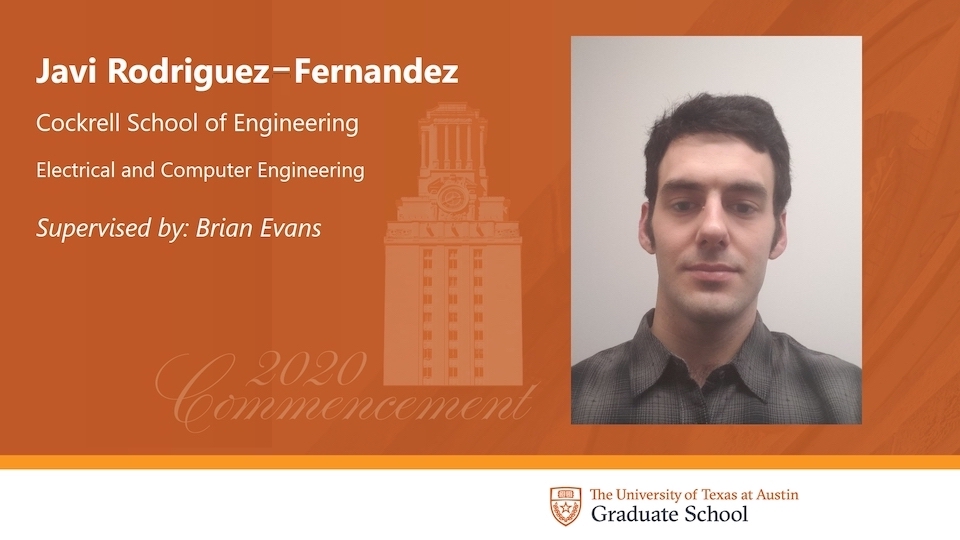
Dr. Javier Rodriguez-Fernandez receiving his PhD degree at the Spring 2020 graduation ceremony
For more information contact: Javier Rodriguez-Fernandez <javi.rf@utexas.edu>
This dissertation will be presented to the Faculty of the Graduate School of The University of Texas at Austin in partial fulfillment of the requirements for the degree of Ph.D. in Electrical Engineering
Abstract
Millimeter Wave Link Configuration with Hybrid MIMO Architectures
Javier Rodriguez-Fernandez, Ph.D.E.E.
The University of Texas at Austin, August 2020
Supervisor:
Prof.
Brian L. Evans
Embedded Signal Processing Laboratory - Wireless Networking and Communications Group
The use of multiple antennas, widely known as MIMO technology, is a key feature to deploy mmWave communication systems enabling high-data-rate applications. With more than two decades of global experience in deploying Wi-Fi and cellular communication using sub-6 GHz frequency bands, simply repurposing these designs for mmWave bands would fail to account for additional propagation impairments and circuit design constraints at these higher frequencies. A solution to overcome the propagation challenges is the use of multiple directional communication beams, whereby proper alignment between transceivers provides sufficient link quality to enable reliable decoding of the transmitted data.
In this dissertation, efficient link configuration solutions suitable for mmWave cellular communications are developed. To gain some insight into the achievable performance of mmWave systems, two broadband channel-estimation-based link configuration solutions are proposed for MIMO-OFDM systems, in which both the transmitter and receiver are assumed to be perfectly synchronized. The proposed solution exploits the spatially common sparsity in the mmWave channel and enables efficient acquisition of the CSI while allowing the use of multiple RF chains on both the transmitter and receiver sides. In a simplified scenario, the CRLB for the channel estimation problem is derived, and the proposed channel estimation algorithms are shown to both outperform prior work in communication performance and exhibit excellent estimation performance. Furthermore, the proposed algorithms are assessed in a more challenging scenario with realistic channel parameters, and it is shown that both near-optimal spectral efficiency and low BER can be attained with lower overhead and computational complexity than prior solutions.
Next, the impact of imperfect CFO synchronization on the channel estimation problem is analyzed under a narrowband channel model. The CRLB for the estimation of the different unknown parameters involved in the problem is theoretically analyzed, and closed-form expressions are provided for the estimation of the different parameters. Under a joint estimation-theoretic and CS framework, a low-complexity multi-stage solution is proposed to estimate both the different unknown synchronization parameters and the large-dimensional mmWave MIMO channel. Different trade-offs between estimation, spectral efficiency, and overhead performance are exposed, and the proposed estimators are shown to be asymptotically optimal in the low SNR regime. The proposed solution is assessed under a channel model with several clusters and rays per cluster, and is shown to attain near-optimal spectral efficiency values in both the low and high SNR regimes. The computational complexity of the proposed solution is also analyzed, in which it is shown to achieve a marginal increase in computational complexity with respect to the solution proposed in the previous contribution.
Finally, the impact of TO, CFO, and PN impairments on the channel estimation problem is analyzed under a broadband channel model. The problem of time-frequency synchronization under PN impairments is theoretically analyzed, and the proposed solutions to the synchronization problem are exploited to estimate the frequency-selective mmWave MIMO channel. The hybrid CRLB for the estimation of the different synchronization impairments is analyzed, and closed-form expressions leveraging the information coupling between the different impairments are provided. The previously proposed joint estimation-theoretic and CS framework is extended to frequency-selective scenarios, and two low-complexity multi-stage solutions are proposed to estimate both the different synchronization impairments and the large-dimensional mmWave MIMO channel. The first solution relies on a batch-processing LMMSE-based EM algorithm to estimate the different synchronization impairments, while the second solution uses a sequential-processing EKF-RTS-based EM algorithm, thereby reducing computational complexity. Thereafter, both the hybrid CRLB for the estimation of the equivalent beamformed complex channels and the estimates for these parameters are exploited to estimate the large-dimensional frequency-selective mmWave MIMO channel.
Finally, a joint PN and data detection algorithm is proposed for data transmission under the 5G NR frame structure. The proposed solutions are evaluated using a 5G NR-based channel model, and different trade-offs between estimation performance, computational complexity, overhead, achievable spectral efficiency and BER are exposed, and comparisons with prior work are also provided. The results show that mmWave link configuration using hybrid MIMO architectures can be established with low overhead without assuming synchronization, even in the low SNR regime.

Dr. Javier Rodriguez-Fernandez receiving his PhD degree at the Spring 2020 graduation ceremony
For more information contact: Javier Rodriguez-Fernandez <javi.rf@utexas.edu>